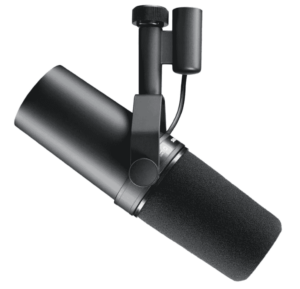Welcome Blessings!
(Tap 🔽 to see more topics!)


Table of Contents
ToggleShure SM7B- The mic that whispers ‘professional’ into your ears, even if you’re starting in your bedroom. It’s the gear that makes you wonder, ‘Could my voice sound like that?’ You’ve seen it everywhere, from your favorite podcasts to those crystal-clear YouTube streams, and you’re curious. Everyone has been there, staring at the specs, wondering if the magic is real or just marketing smoke.
The truth is, while the SM7B carries a legendary status, it’s not a plug-and-play miracle. You’ll need a bit of know-how to unlock its full potential. Think of it as a high-performance engine: excellent, but it requires the proper tuning. So, let’s cut through the jargon and get real. In this article, you will learn the straight-up benefits, the real-world hurdles, and how to dial in that sweet spot so your voice shines, no matter your experience level.
The Shure SM7B has earned its place as a legend in the audio world, and for good reason. It’s not just another microphone; it’s the kind that brings a rich, warm tone to your voice, like you’re in a professional studio, even if you’re recording from your kitchen table. This mic is a dynamic cardioid, which means it’s designed to focus on what’s directly in front of it while pushing background noise to the side.
Why is this important? Unlike some mics that pick up every tiny sound, the SM7B lets your voice shine. It’s why you hear that smooth, clean sound on podcasts, streams, and professional recordings. Its reputation is so solid that it’s been used by some of the biggest names in the business, including the legendary Michael Jackson on his iconic ‘Thriller’ album. That’s a serious stamp of approval. If it helped create an iconic sound, it’s worth paying attention to.
Before jumping into the SM7B, it’s essential to know that not all microphones are built the same. Choosing the right mic depends on your specific needs.
Best for: Podcasters, streamers, live performances, untreated rooms
Pros: Durable, excellent noise rejection, handles loud sounds well
Cons: Requires more gain, not as sensitive as condenser mics
Dynamic mics are rugged and focused, meaning they pick up sound only from the front while rejecting background noise. They work great in non-studio environments where you don’t want to capture unwanted sounds.
Best for: Studio vocals, voice-over work, recording instruments
Pros: Highly sensitive, captures crisp and detailed audio
Cons: Picks up background noise, requires phantom power
These are ideal for professional recording studios but can be problematic in noisy spaces since they capture everything. They need 48V phantom power to operate.
Best for: Vintage-style recordings, warm and natural sound
Pros: Smooth sound, excellent for acoustic instruments and vocals
Cons: Fragile, expensive, not great for loud environments
Ribbon mics have a classic, warm sound and are often used in jazz and classical music recordings.
Best for: Beginners, casual podcasters, home offices
Pros: Plug-and-play, no extra gear needed, budget-friendly
Cons: Lower audio quality compared to XLR mics
USB mics like the Blue Yeti or Audio-Technica AT2020USB+ are great starter mics but don’t offer the same professional sound quality as XLR microphones like the SM7B.
Getting the Shure SM7B to sound amazing is simpler than you might think, even if you’re new to this microphone. It delivers incredible quality, but it needs a little love to shine.
1. Powering Up: Gain and Your Audio Setup. The SM7B needs much power to sound its best. It’s just how it’s built. Think of it like a car that needs high-octane fuel. You’ve got a couple of solid options here:
2. Finding Your Sweet Spot: Mic Placement. Where you put the mic makes a huge difference.
3. Taming Those ‘Pop’ Sounds: Windscreens. The SM7B comes with a built-in windscreen, which is excellent. But if you’re serious about cutting down on those ‘pop’ sounds, you can upgrade to the A7WS windscreen. It’s like a super-shield for your mic.
Now, you’ve got the SM7B plugged in, sweet! Now, let’s make sure it sounds like a million bucks. It’s all about fine-tuning those settings. Think of it like adjusting the spices in your favorite recipe… a little tweak here and there makes a huge difference.
1. Gain: Finding That Sweet Spot
Okay, gain. This is where a lot of people get tripped up. The goal? You want your voice to hit around -12dB to -6dB on your meter. That’s the zone where you’re loud enough but not so loud you start getting that nasty distortion.
Just a heads-up: too much gain, and you’ll get that annoying hiss. Too little, and you’ll sound like you’re whispering from across the room. Finding the right balance is key.
2. EQ: Making Your Voice Pop
Want that pro-level clarity? Below are a few EQ tricks you can try:
Don’t worry; most audio interfaces and recording software have built-in EQ tools. Just experiment and see what sounds best to your ears.
3. Compression and Noise Reduction: Polishing Your Sound
Sometimes, your voice might jump up and down in volume. That’s where compression comes in. It smooths things out. Below is how to set it up:
And for those annoying background noises? A noise gate set around 40 -40dB can work wonders. It’ll cut out any hum or buzz when you’re not talking. Remember, these are just starting points. Your voice and setup are unique, so don’t be afraid to experiment. With a bit of tweaking, you’ll find your perfect sound!
Imagine your voice is like water flowing through pipes. The SM7B is the source, and we need to smoothly get that “water” (your voice) to your computer. We’ll use two “pipes” to make it happen: the dbx 286s and the Focusrite Solo.
A. Why Use Both?
B. How to Connect Them: Step-by-Step
1. SM7B to dbx 286s (First Pipe). You’ll need an XLR cable (it has three holes).
2. dbx 286s to Focusrite Solo (Second Pipe). Get another XLR cable.
3. Focusrite Solo to Computer (Computer Connection). Use the USB cable that came with your Focusrite Solo.
C. Setting the Levels (Making Sure the “Water” Flows Right)
D. Important Tip:
In simple words, you’re using the dbx 286s to clean up and boost your voice and then the Focusrite Solo to send that clean, strong voice to your computer.
1. Why does the Shure SM7B need so much gain?
2. Can I use the Shure SM7B without a preamp?
3. What’s the difference between using the SM7B with a dbx 286s vs a Focusrite Solo?
4. Do I need a Cloudlifter with the Focusrite Solo?
5. How do I reduce background noise when using the Shure SM7B?
6. What is the best audio interface for the Shure SM7B?
7. How can I improve the sound quality of the Shure SM7B in a home studio?
The Shure SM7B is a fantastic choice for anyone looking to improve their audio quality, whether you’re a podcaster, streamer, or musician. While it may require some extra gain to perform at its best, pairing it with the right equipment—like the dbx 286s or Focusrite Solo 3rd Gen can unlock its full potential, ensuring that you get clear, professional-sounding audio without a hitch.
The dbx 286s offers additional tools such as compression, enhancement, and de-essing, which can refine the SM7B’s sound, making it an excellent choice for those who want to shape their audio precisely. On the other hand, the Focusrite Solo is a more affordable, beginner-friendly interface that still provides enough gain for the SM7B, with the added benefit of simplicity and ease of use.
No matter what gear you choose, the Shure SM7B remains a legendary mic for a reason. You’ll get a powerful, dynamic sound that works for various applications with the proper setup. Remember, the key to getting the best out of this mic is proper gain management, mic placement, and the correct processing equipment to suit your needs.
Whether you’re just starting out or upgrading your gear, the Shure SM7B is definitely a mic worth considering. With the proper setup, you’ll enjoy top-tier sound for years! Voila! Until next time!
Information Updated Date: September 21, 2024
Original Published Date: February 12, 2022
Disclosure: Shopping through our Amazon links costs you NO EXTRA FEES! Please note that we do not process payments or confirm orders. If you click the link or button, it directs you to Amazon’s website or app, where Amazon handles all transactions. This article actively participates in the Amazon Associates Program, an affiliate initiative designed to enable websites to earn referral fees by advertising and linking to Amazon.co.jp. We only endorse the products and services we have tested and strongly believe in; hence, our recommendations are rooted in this unwavering trust.
M. Dochi is a former architecture graduate and a licensed architect who traded in his blueprints for a new adventure in Japan. With courage, he followed his heart and found a job that aligned better with his interests, ultimately bringing him joy and fulfillment.
In addition, M. Dochi has a passion for acquiring new languages. He constantly seeks innovative ways to broaden his knowledge and improve his Japanese and English skills.
When it comes to buying anything, he's an actual investigator! He takes the extra time to research and compare products to ensure he's getting the best value for his money. Not only that, but he's also honing his English skills by writing reviews and sharing his thoughts on anything that interests him.
